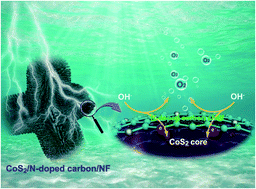当前位置:
X-MOL 学术
›
J. Mater. Chem. A
›
论文详情
Our official English website, www.x-mol.net, welcomes your
feedback! (Note: you will need to create a separate account there.)
CoS2@N-doped carbon core–shell nanorod array grown on Ni foam for enhanced electrocatalytic water oxidation
Journal of Materials Chemistry A ( IF 10.7 ) Pub Date : 2020/03/10 , DOI: 10.1039/d0ta00777c Lang Pei 1, 2, 3, 4 , Jiasong Zhong 1, 2, 3, 4 , Taozhu Li 5, 6, 7, 8, 9 , Wangfeng Bai 1, 2, 3, 4 , Shiting Wu 1, 2, 3, 4 , Yongjun Yuan 1, 2, 3, 4 , Yifan Chen 1, 2, 3, 4 , Zhengtao Yu 5, 6, 7, 8, 9 , Shicheng Yan 5, 6, 7, 8, 9 , Zhigang Zou 5, 6, 7, 8, 9
Journal of Materials Chemistry A ( IF 10.7 ) Pub Date : 2020/03/10 , DOI: 10.1039/d0ta00777c Lang Pei 1, 2, 3, 4 , Jiasong Zhong 1, 2, 3, 4 , Taozhu Li 5, 6, 7, 8, 9 , Wangfeng Bai 1, 2, 3, 4 , Shiting Wu 1, 2, 3, 4 , Yongjun Yuan 1, 2, 3, 4 , Yifan Chen 1, 2, 3, 4 , Zhengtao Yu 5, 6, 7, 8, 9 , Shicheng Yan 5, 6, 7, 8, 9 , Zhigang Zou 5, 6, 7, 8, 9
Affiliation

|
Developing a highly efficient and low-cost oxygen-evolution-reaction (OER) electrocatalyst is an important route to overcome the rate-determining step of water splitting. Here, we directly grew a CoS2 nanoarray core with an N-doped graphitic carbon (NGC) shell on Ni foam (NF) to construct a core–shell nanorod array electrode, CoS2@NGC@NF. The CoS2 core with a high work function (∼5.5 eV) tends to capture electrons from the NGC layer (4.5–5.2 eV) to induce an electron-poor NGC shell with a significant downshift of the carbon Fermi level, facilitating the adsorption of O-containing intermediates and affording decreased activation energy during the OER process. As a result, the three-dimensional NGC encapsulated CoS2 array assembly exhibited excellent electrocatalytic OER activity with a low overpotential of 243 mV at a current density of 10 mA cm−2 and a small Tafel slope of 71 mV dec−1 in 1.0 M KOH. Our findings may suggest that manipulating the interface energetics by the work function difference is a potential route to the design of high-performance OER electrocatalysts.
中文翻译:

镍泡沫上生长的CoS2 @ N掺杂碳核-壳纳米棒阵列,用于增强电催化水氧化
开发高效,低成本的氧演化反应(OER)电催化剂是克服水分解速率确定步骤的重要途径。在这里,我们直接在Ni泡沫(NF)上生长了带有N掺杂石墨碳(NGC)壳的CoS 2纳米阵列核,以构建核壳纳米棒阵列电极CoS 2 @ NGC @ NF。具有高功函(〜5.5 eV)的CoS 2核趋向于从NGC层(4.5–5.2 eV)捕获电子,以诱导电子贫乏的NGC壳层,碳费米能级显着下降,从而促进了碳的吸附。含O的中间体,在OER过程中提供降低的活化能。结果,三维NGC封装的CoS 2阵列组件表现出出色的电催化OER活性,在10 mA cm -2的电流密度下,低过电势为243 mV,在1.0 M KOH中的Tafel斜率小,为71 mV dec -1。我们的发现可能表明,通过功函数差异来控制界面能学是设计高性能OER电催化剂的潜在途径。
更新日期:2020-04-08
中文翻译:

镍泡沫上生长的CoS2 @ N掺杂碳核-壳纳米棒阵列,用于增强电催化水氧化
开发高效,低成本的氧演化反应(OER)电催化剂是克服水分解速率确定步骤的重要途径。在这里,我们直接在Ni泡沫(NF)上生长了带有N掺杂石墨碳(NGC)壳的CoS 2纳米阵列核,以构建核壳纳米棒阵列电极CoS 2 @ NGC @ NF。具有高功函(〜5.5 eV)的CoS 2核趋向于从NGC层(4.5–5.2 eV)捕获电子,以诱导电子贫乏的NGC壳层,碳费米能级显着下降,从而促进了碳的吸附。含O的中间体,在OER过程中提供降低的活化能。结果,三维NGC封装的CoS 2阵列组件表现出出色的电催化OER活性,在10 mA cm -2的电流密度下,低过电势为243 mV,在1.0 M KOH中的Tafel斜率小,为71 mV dec -1。我们的发现可能表明,通过功函数差异来控制界面能学是设计高性能OER电催化剂的潜在途径。











































 京公网安备 11010802027423号
京公网安备 11010802027423号